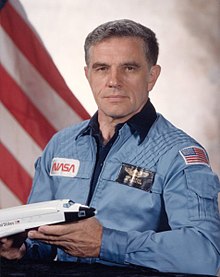Karl Henize
American - (NASA)
Deceased
Date of Birth: Oct. 17, 1926
Date of Death: Oct. 5, 1993
Karl Gordon Henize, Ph.D. was an American astronomer, space scientist, NASA astronaut, and professor at Northwestern University. Henize was selected as a scientist-astronaut by NASA in August 1967. Henize was a mission specialist on the Spacelab-2 mission (STS-51-F) which launched from Kennedy Space Center, Florida, on July 29, 1985. He died in 1993, during a Mount Everest expedition. The purpose of this expedition was to test for NASA a meter called a Tissue Equivalent Proportional Counter (TEPC): testing at different altitudes (17,000 ft, 19,000 ft and 21,000 ft) would reveal how people’s bodies would be affected, including the way bodily tissues behaved, when struck by radiation, and this was important for the planning of long duration space missions.
Space Shuttle Challenger / OV-099 | STS-51-F
National Aeronautics and Space Administration | United States of AmericaKennedy Space Center, FL, USA
July 29, 1985, 9 p.m.
The National Aeronautics and Space Administration is an independent agency of the executive branch of the United States federal government responsible for the civilian space program, as well as aeronautics and aerospace research. NASA have many launch facilities but most are inactive. The most commonly used pad will be LC-39B at Kennedy Space Center in Florida.
Long March 3B/E
Fengyun-4C
Launch Complex 2 (LC-2) - Xichang Satellite Launch Center, People's Republic of ChinaChina's geostationary meteorological satellite program FY-4 (Feng Yun 4) is the second generation of chinese geostationary meteorological satellites.
Long March 8A
SatNet LEO Group 17
Commercial LC-1 - Wenchang Space Launch Site, People's Republic of ChinaA batch of 9 Low Earth Orbit communication satellites for the Chinese state owned SatNet constellation operated by the China Satellite Network Group.…
Soyuz 2.1a
Obzor-R No.1
43/4 (43R) - Plesetsk Cosmodrome, Russian FederationNote: Assignment of payloads to this launch is uncertain. The Russian Obzor-R satellite is a planned X-band radar earth observation satellite desi…
LVM-3 (GSLV Mk III)
BlueBird Block 2 #1
Satish Dhawan Space Centre Second Launch Pad - Satish Dhawan Space Centre, IndiaAST SpaceMobile’s Block 2 BlueBird satellites are designed to deliver up to 10 times the bandwidth capacity of the BlueBird Block 1 satellites, requi…
Long March 12A
Demo Flight
Long March 12A Pad - Jiuquan Satellite Launch Center, People's Republic of ChinaFirst test launch of CASC/SAST’s Long March 12A rocket, with a dummy payload. The rocket’s 1st stage attempted to land on a landing pad about 300 km …



